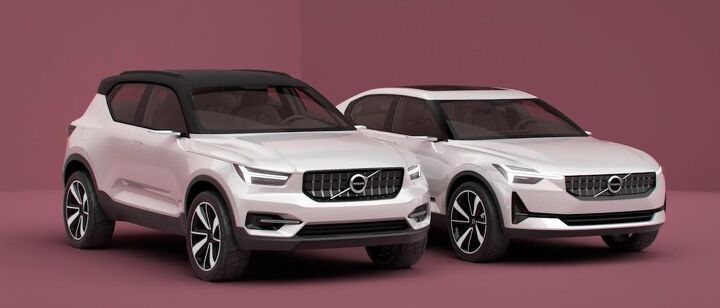Volvo's First Electric Model Will Roll Out With a Minimum 250-mile Range

Though its debut will lag that of Chevrolet’s Bolt and the Tesla Model 3, Volvo’s first entry into the world of all-electric vehicles looks to be right on par with the current generation’s maximum range and requisite financial investment. Starting between $35,000 and $40,000 when it debuts in 2019, the Swedish EV should be capable of at least 250 miles between charges.
Away from the main stage of the Geneva International Motor Show, CEO of Volvo America Lex Kerssemakers indicated to journalists that the standards set by the Bolt would be the benchmark. “That’s what I put in as the prerequisite for the United States,” Kerssemakers said. “If I want to make a point in the United States, if I want to make volumes, that’s what I believe I need.”
What it will look like remains unconfirmed, however. Volvo hasn’t given an indication if the EV will be a standalone unit or a refitted model from the company’s existing lineup. Based on the narrow timeline, the smart money is on one of its smaller cars being converted to a BEV — perhaps the upcoming compact XC40. Still, depending on where the model’s development process stands, Volvo could come to market with something unique by 2019. The C30 DRIVe Electric concept came out in 2010, closely resembling a production unit, so the company has definitely been thinking about EVs for a while.
Kerssemakers admitted that the schedule would be challenging, but claimed that Volvo’s modular platforms would make it possible. The company’s Scalable Product Architecture underpins the majority if its new vehicles, but the CEO was likely referring to its Compact Modular Architecture, which underpins the XC40.
The company also has a Modular Electrification Platform currently in development specifically for BEVs, but details on that are extremely limited. It hasn’t specified where that project is in terms of completion, just that it provides modular building blocks for electrification than will allow Volvo to deliver vehicles ranging between 100 and 450 kW of propulsive power, with battery packs of “up to 100 kWh in size.”
Volvo could certainly build a larger EV off the larger platform but the added weight would likely diminish range without being supplemented by a large battery pack. The price point Kerssemakers mentioned takes that off the table and replaces it with something smaller. He’s not about to sacrifice range for legroom.
“Why are people reluctant to buy a full electric car?” Kerssemakers said. “It’s between the ears. It’s that they believe there’s not sufficient range.”
[Source: Automotive News] [Image: Volvo]

A staunch consumer advocate tracking industry trends and regulation. Before joining TTAC, Matt spent a decade working for marketing and research firms based in NYC. Clients included several of the world’s largest automakers, global tire brands, and aftermarket part suppliers. Dissatisfied with the corporate world and resentful of having to wear suits everyday, he pivoted to writing about cars. Since then, that man has become an ardent supporter of the right-to-repair movement, been interviewed on the auto industry by national radio broadcasts, driven more rental cars than anyone ever should, participated in amateur rallying events, and received the requisite minimum training as sanctioned by the SCCA. Handy with a wrench, Matt grew up surrounded by Detroit auto workers and managed to get a pizza delivery job before he was legally eligible. He later found himself driving box trucks through Manhattan, guaranteeing future sympathy for actual truckers. He continues to conduct research pertaining to the automotive sector as an independent contractor and has since moved back to his native Michigan, closer to where the cars are born. A contrarian, Matt claims to prefer understeer — stating that front and all-wheel drive vehicles cater best to his driving style.
More by Matt Posky
Latest Car Reviews
Read moreLatest Product Reviews
Read moreRecent Comments
- CoastieLenn Could be a smart move though. Once the standard (that Tesla owns and designed) is set, Tesla bows out of the market while still owning the rights to the design. Other companies come in and purchase rights to use it, and Tesla can sit back and profit off the design without having to lay out capital to continue to build the network.
- FreedMike "...it may also be true that they worry that the platform is influencing an entire generation with quick hits of liberal political thought and economic theory."Uh...have you been on TikTok lately? Plenty of FJB/MAGA stuff going on there.
- AZFelix As a child I loved the look and feel of the 'woven' black vinyl seat inserts.
- Aja8888 Maybe he's putting the cost savings into Cybertruck production?
- Kwik_Shift_Pro4X The dominoes start to fall...


































Comments
Join the conversation
If they can meet that pricing target, then damn, son, things are about to get interesting. That's Chevy Bolt money (unless they're figuring the price with the tax credit already included). What's the secret? Made in China and available only in lots of 5000 via Alibaba.cn?
The last SUV I had was a 93 Land Cruiser. It could't get 250 miles of range out of a tank of gas. If these Range figures hold up this is going to get interesting for sure.